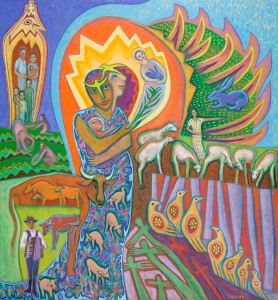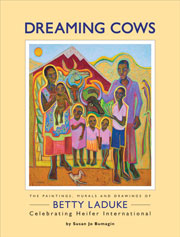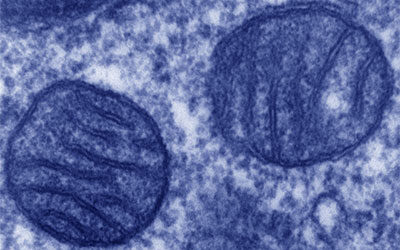Poland: Tree of Life ©Betty LaDuke bettyladuke.com
What are some of the commonalities found in traditional diets, like those in the various cultures studied by Weston Price, aside from being animal-based?
Sally’s response:
• The diets of healthy primitive and nonindustrialized peoples contain no refined or denatured foods such as refined sugar or corn syrup; white flour; canned foods; pasteurized, homogenized, skim or low-fat milk; refined or hydrogenated vegetable oils; protein powders; artificial vitamins or toxic additives and colorings.
• All traditional cultures consume some sort of animal protein and fat from fish and other seafood; water and land fowl; land animals; eggs; milk and milk products; reptiles; and insects.
• Primitive diets contain at least four times the calcium and other minerals and TEN times the fat soluble vitamins from animal fats (vitamin A, vitamin D and the Price Factor–now believed to be vitamin K2) as the average American diet.
• In all traditional cultures, some animal products are eaten raw.
• Primitive and traditional diets have a high food-enzyme content from raw dairy products, raw meat and fish; raw honey; tropical fruits; cold-pressed oils; wine and unpasteurized beer; and naturally preserved, lacto-fermented vegetables, fruits, beverages, meats and condiments.
• Seeds, grains and nuts are soaked, sprouted, fermented or naturally leavened in order to neutralize naturally occuring antinutrients in these foods, such as phytic acid, enzyme inhibitors, tannins and complex carbohydrates.
• Total fat content of traditional diets varies from 30% to 80% but only about 4% of calories come from polyunsaturated oils naturally occurring in grains, pulses, nuts, fish, animal fats and vegetables. The balance of fat calories is in the form of saturated and monounsaturated fatty acids.
• Traditional diets contain nearly equal amounts of omega-6 and omega-3 essential fatty acids.
• All primitive diets contain some salt.
• Traditional cultures consume animal bones, usually in the form of gelatin-rich bone broths.
• Traditional cultures make provisions for the health of future generations by providing special nutrient-rich foods for parents-to-be, pregnant women and growing children; by proper spacing of children; and by teaching the principles of right diet to the young.
 photo: Poland: Tree of Life ©Betty LaDuke | Artist Betty LaDuke works with Heifer International to end world hunger by offering families in need long term solutions that work. One of the cornerstones of Heifer’s approach is “Passing on the Gift”, a cycle of sustainability where people share the offspring of their animals along with their knowledge, resources, and skills to create a circle of self-reliance that reaches around the globe.
photo: Poland: Tree of Life ©Betty LaDuke | Artist Betty LaDuke works with Heifer International to end world hunger by offering families in need long term solutions that work. One of the cornerstones of Heifer’s approach is “Passing on the Gift”, a cycle of sustainability where people share the offspring of their animals along with their knowledge, resources, and skills to create a circle of self-reliance that reaches around the globe.








0 Comments